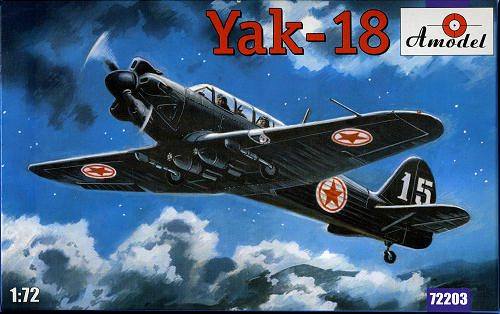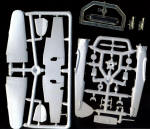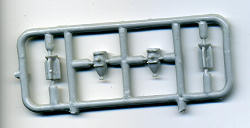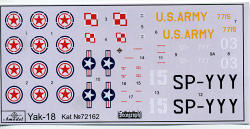
Amodel 1/72 Yak-18
| KIT #: | 72203 |
| PRICE: | $10.45 at www.scale-model-kits.com |
| DECALS: | Four options |
| REVIEWER: | Scott Van Aken |
| NOTES: | Treat as a short run kit. |

| HISTORY |
The subject of this kit is one of the early Yak-18 trainers that were ubiquitous throughout the Soviet-influenced block of nations from Afghanistan to Zambia, and served with the North Korean/Chinese air force during the Korean War as a night nuisance bomber.
| THE KIT |
 Molded in a light grey plastic with thick sprues and rather thin sprue gates, this is very much typical of the A-model kits I've built in the past. Surface detail is well done with engraved lines and subdued fabric representation. The somewhat soft plastic means that care will be needed when removing the smaller parts. I found the usual flash on nearly all the parts but nothing major and typical of low pressure molding.
Molded in a light grey plastic with thick sprues and rather thin sprue gates, this is very much typical of the A-model kits I've built in the past. Surface detail is well done with engraved lines and subdued fabric representation. The somewhat soft plastic means that care will be needed when removing the smaller parts. I found the usual flash on nearly all the parts but nothing major and typical of low pressure molding.
 The single transparency is thick and has somewhat indistinct canopy frame lines. Unlike the earlier boxing, this one has plastic bombs instead of the cast metal ones and the detailing on these seems to be a bit better. The cockpit is very basic consisting of a floor, two seats and two instrument panels. No control sticks or sidewall detail or rudder panels. However, not much detail will be visible through the rather thick transparency. One thing I did find that was rather cool is that the elevators are slightly deflected downward with the trim tabs correctly deflected up a bit. Can't think of many other kits that provide this.
The single transparency is thick and has somewhat indistinct canopy frame lines. Unlike the earlier boxing, this one has plastic bombs instead of the cast metal ones and the detailing on these seems to be a bit better. The cockpit is very basic consisting of a floor, two seats and two instrument panels. No control sticks or sidewall detail or rudder panels. However, not much detail will be visible through the rather thick transparency. One thing I did find that was rather cool is that the elevators are slightly deflected downward with the trim tabs correctly deflected up a bit. Can't think of many other kits that provide this.
 The instructions just show a general area for placement and it appears they are to be mounted under each of the wing roots. Markings are provided for four aircraft. One in Dark Green over Light Blue and another in overall Black for the North Korean AF. The reason for the 12 roundels is that one is a stencil variety. There is another for the Polish Air Force with civil registration (which may have been required on training aircraft), and one for the USAF, all from about 1950 if I read the cryptic '50th' commentary for each markings option correctly. I'm not sure just how opaque the markings are, but have found previous A-model kits to have usable decals. Instructions are quite usable and well drawn.
The instructions just show a general area for placement and it appears they are to be mounted under each of the wing roots. Markings are provided for four aircraft. One in Dark Green over Light Blue and another in overall Black for the North Korean AF. The reason for the 12 roundels is that one is a stencil variety. There is another for the Polish Air Force with civil registration (which may have been required on training aircraft), and one for the USAF, all from about 1950 if I read the cryptic '50th' commentary for each markings option correctly. I'm not sure just how opaque the markings are, but have found previous A-model kits to have usable decals. Instructions are quite usable and well drawn.
| CONCLUSIONS |
| REFERENCES |
http://en.wikipedia.org
February 2010
If you would like your product reviewed fairly and fairly quickly, please contact the editor or see other details in the Note to Contributors.
Back to the Previews Index Page